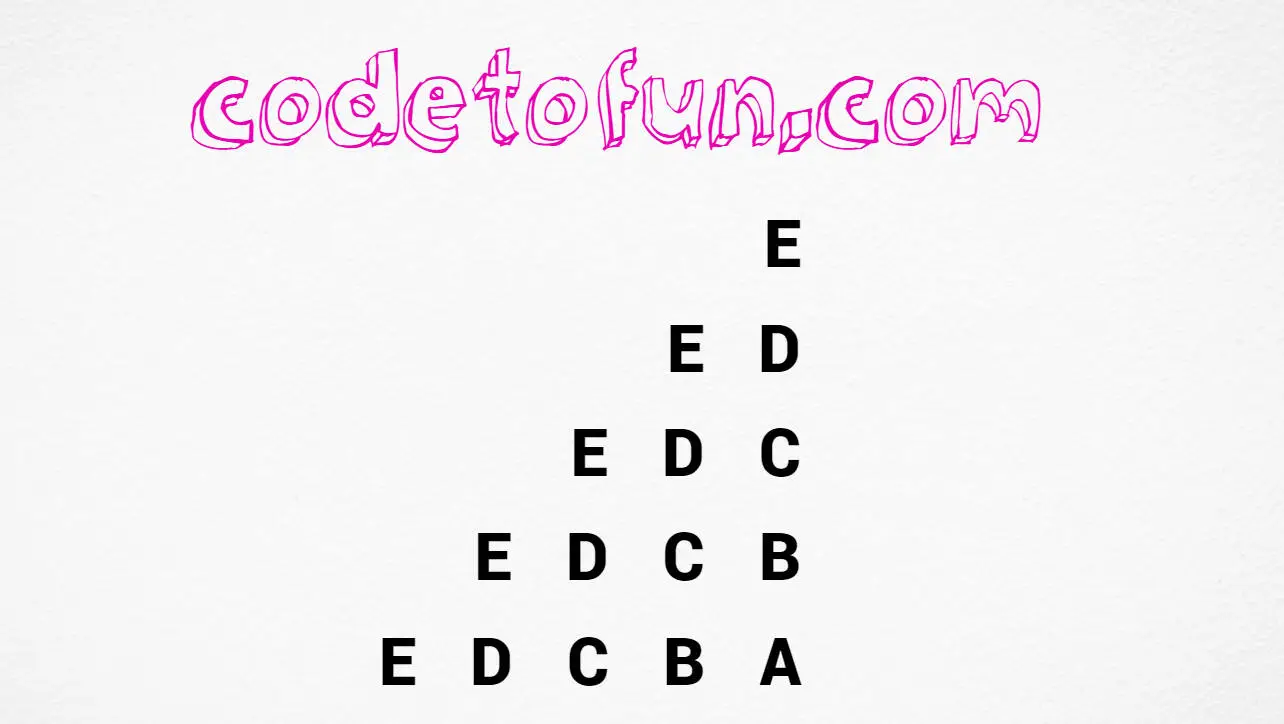
PHP Topics
- PHP Intro
- PHP String Functions
- PHP Interview Programs
- PHP Star Pattern
- PHP Number Pattern
- PHP Alphabet Pattern
- Alphabet Pattern 1
- Alphabet Pattern 2
- Alphabet Pattern 3
- Alphabet Pattern 4
- Alphabet Pattern 5
- Alphabet Pattern 6
- Alphabet Pattern 7
- Alphabet Pattern 8
- Alphabet Pattern 9
- Alphabet Pattern 10
- Alphabet Pattern 11
- Alphabet Pattern 12
- Alphabet Pattern 13
- Alphabet Pattern 14
- Alphabet Pattern 15
- Alphabet Pattern 16
- Alphabet Pattern 17
- Alphabet Pattern 18
- Alphabet Pattern 19
- Alphabet Pattern 20
- Alphabet Pattern 21
- Alphabet Pattern 22
- Alphabet Pattern 23
- Alphabet Pattern 24
- Alphabet Pattern 25
- Alphabet Pattern 26
- Alphabet Pattern 27
- Alphabet Pattern 28
- Alphabet Pattern 29
- Alphabet Pattern 30
- Alphabet Pattern 31
- Alphabet Pattern 32
- Alphabet Pattern 33
- Alphabet Pattern 34
PHP Alphabet Pattern 23

Photo Credit to CodeToFun
PHP Alphabet Pattern 23
Here`s a program that prints the above alphabet pattern using PHP Programming:
<?php
$alpha = range('A', 'Z');
for($i=4; $i>=0; $i--)
{
for($j=0; $j<$i; $j++)
echo " ";
for($j=4; $j>=$i; $j--)
echo $alpha[$j] . " ";
echo "<br>";
}
?>💻 Testing the Program
When you run the above program, it will print the following output:
E
E D
E D C
E D C B
E D C B A
🧠 How the Program Works
Let's break down the logic behind the code:
- <?php - This indicates the beginning of a PHP script.
- $alpha = range('A', 'Z'); - This line creates an array $alpha containing uppercase letters from 'A' to 'Z'. The range() function generates an array of values within a specified range.
- for($i=4; $i>=0; $i--) - This initiates a loop with a variable $i starting from 4 and decreasing by 1 in each iteration until it becomes 0. This loop controls the number of rows in the pattern.
- Inside the first loop:
- for($j=0; $j<$i; $j++) - This nested loop initializes a variable $j to 0 and increments it in each iteration until it is less than $i. This loop prints spaces to create an indentation effect, shifting the subsequent letters to the right in each row.
- for($j=4; $j>=$i; $j--) - Another nested loop is used here, initializing a variable $j to 4 and decreasing it in each iteration until it becomes greater than or equal to $i. This loop prints the letters in reverse order from the $alpha array, based on the current value of $j.
- echo $alpha[$j] . " "; - This prints the letter from the $alpha array at index $j and adds a non-breaking space after it. This creates a space between the letters in the pattern.
- echo "<br>"; - After each row of letters is printed, this statement adds an HTML line break (<br>) to move to the next line.
- ?> - This marks the end of the PHP script.
💯 Tips for Enhancement:
Explore the versatility of this pattern by adjusting its parameters. Whether you increase or decrease the size, tweak the spacing, or modify the characters used, each change opens up a world of possibilities, allowing you to customize and create your unique visual effects.
✔ Conclusion:
Creating visually appealing patterns is not only a fun endeavour but also a great way to enhance your programming or design skills. We hope this tutorial has inspired you to explore the world of creative coding. Share your creations with us, and let your imagination run wild!
🤗 Closing Call-to-Action:
We'd love to see your unique interpretations of the alphabet pattern. Share your creations in the comments below, and don't hesitate to reach out if you have any questions or suggestions for future tutorials. Happy coding!
👨💻 Join our Community:
Author

For over eight years, I worked as a full-stack web developer. Now, I have chosen my profession as a full-time blogger at codetofun.com.
Buy me a coffee to make codetofun.com free for everyone.
Buy me a CoffeeShare Your Findings to All
Recent Post in PHP














If you have any doubts regarding this article (PHP Alphabet Pattern 23) please comment here. I will help you immediately.